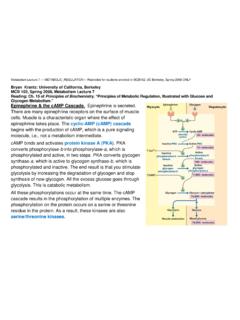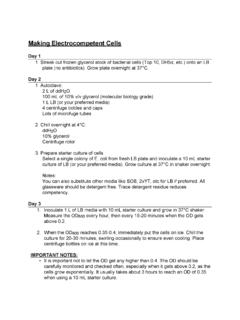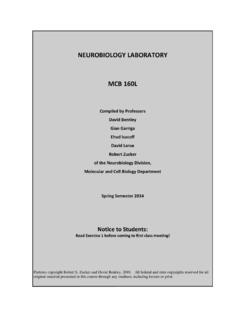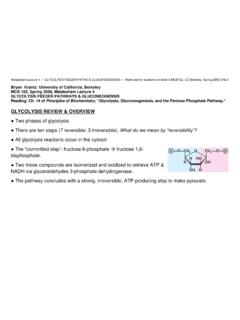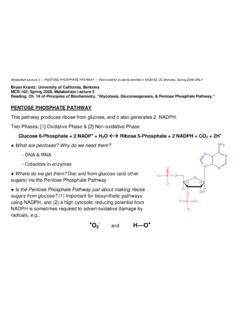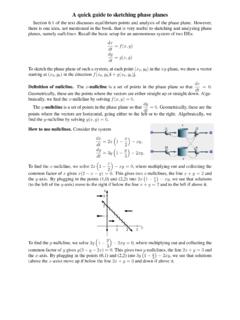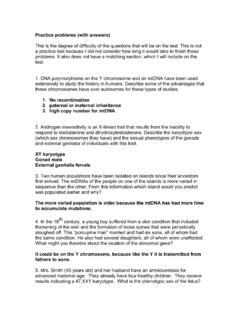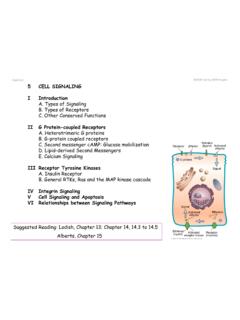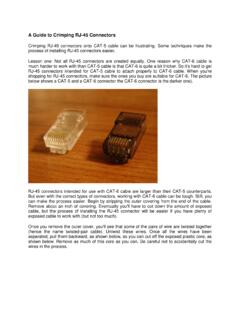Transcription of PowerPoint Presentation - ALZHEIMER’S DISEASE
1 ALZHEIMER S DISEASEMary-LetitiaTimiras HospitalSummit, New JerseyTopics Covered Demography Clinical manifestations Pathophysiology Diagnosis Treatment Future trendsPrevalence and Impact of ADPrevalence and Impact of ADAD is the most common cause of dementia in people AD is the most common cause of dementia in people 65 years and older65 years and olderAffects 10% of people over the age of 65 and 50% of Affects 10% of people over the age of 65 and 50% of people over the age of 85people over the age of 85 Approximately 4 million AD patients in the United StatesApproximately 4 million AD patients in the United StatesAnnual treatment costs = $100 billionAnnual treatment costs = $100 billionAD is the fourth leading cause of death in the United StatesAD is the fourth leading cause of death in the United StatesThe overwhelming
2 Majority of patients live at home and The overwhelming majority of patients live at home and are cared for by family and friendsare cared for by family and friendsEvans DA. Milbank Q. 1990;68:267-289. Alzheimer s Association. Available at: Accessed 5/9 DIAGNOSIS Alzheimer s DISEASE Vascular (multi-infarct) dementia dementia associated with Lewy bodies Delirium Depression Other (alcohol, Parkinson's DISEASE [PD], Pick s DISEASE , frontal lobe dementia , neurosyphilis)DELIRIUM vs dementia Delirium and dementia often occur together in older hospitalized patients; the distinguishing signs of delirium are: Acute onset Cognitive fluctuations over hours or days Impaired consciousness and attention Altered sleep cyclesVASCULAR dementia Development of cognitive deficits manifested by both impaired memory aphasia, apraxia, agnosia, disturbed executive function Significantly impaired social, occupational function Focal neurologic symptoms & signs or evidence of cerebrovascular DISEASE Deficits occur in absence of deliriumDEPRESSION vs dementia The symptoms of depression and dementia often overlap.
3 Patients with primary depression: Demonstrate motivation during cognitive testing Express cognitive complaints that exceed measured deficits Maintain language and motor skillsProjected Prevalence of ADProjected Prevalence of Million AD Cases Today4 Million AD Cases Today Over 14 Million Projected Within a GenerationOver 14 Million Projected Within a GenerationYearEvans DA et al. Milbank Quarterly. 1990;68 Progress of Alzheimer s DiseaseThe Progress of Alzheimer s scoreEarly diagnosisMild-moderateSevereCognitive symptomsLoss of ADLB ehavioral problemsNursing home placementDeathAlzheimer s DISEASE Progresses Alzheimer s DISEASE Progresses Through Distinct StagesThrough Distinct StagesMildModerateSevereMemory lossLanguageproblemsMood swingsPersonalitychangesDiminishedjudgme ntBehavioral, personalitychangesUnable to learn/recallnew infoLong-term memory affectedWandering, agitation,aggression, confusionRequire assistance w/ADLGait, incontinence,motor disturbancesBedriddenUnable to perform ADLP lacement in long-term careneededDementia/Alzheimer sStageSymptomsWHAT IS dementia ?
4 An acquired syndrome of decline in memory and other cognitive functions sufficient to affect daily life in an alert patient Progressive and disabling NOT an inherent aspect of aging Different from normal cognitive lapsesNormal LapsesDementia Not recognizing family member Forgetting to serve meal just prepared Substituting inappropriate words Getting lost in own neighborhood Forgetting a name Leaving kettle on Finding right word Forgetting date or dayNormal LapsesDementia Not recognizing numbers Putting iron in freezer Rapid mood swings for no reason Sudden, dramatic personality change Trouble balancing checkbook Losing keys, glasses Getting blues in sad situations Gradual changes with agingRISK FACTORS FOR dementia Age Family history Head injury Fewer years of educationTHE GENETICS OF dementia Mutations of chromosomes 1, 14, 21 Rare early -onset (before age 60) familial forms of dementia Down syndrome Apolipoprotein E4 on chromosome 19 Late-onset AD APOE*4 allele risk & onset age in dose-related fashion APOE*2 allele may have protective effectPROTECTIVE FACTORS UNDER STUDY Estrogen replacement therapy after menopause NSAIDs AntioxidantsLEWY BODY dementia dementia Visual hallucinations Parkinsonian signs Alterations of alertness or attentionPathology of AD There are 3 consistent neuropathologicalhallmarks.
5 Amyloid-rich senile plaques Neurofibrillarytangles Neuronal degeneration These changes eventually lead to clinical symptoms, but they begin years before the onset of symptoms -amyloidPlaquesImmunocytochemical staining of senile plaques in the isocortex of a brain of a human with AD (anti-amyloid antibody)NeurofibrillaryTanglesImmunocyt ochemical staining of neurofibrillary tangles in the isocortex of the brain of a human with AD (anti-tau antibody) CholinergicHypothesis Acetylcholine (ACh) is an important neurotransmitter in areas of the brain involved in memory formation Loss of AChactivity correlates with the severity of AD BartusRT et al. Science. 1982;217 Inhibitors Drugs used to treat Alzheimer s DISEASE act by inhibiting acetylcholinesterase activity These drugs block the esterase-mediated metabolism of acetylcholine to choline and acetate.
6 This results in: Increased acetylcholine in the synaptic cleft Increased availability of acetylcholine for postsynaptic and presynaptic nicotinic (and muscarinic) acetylcholine receptorsNordberg A, Svensson A-L. Drug Safety. 1998;19 InhibitionPostsynaptic nerve terminalNicotinic receptorPresynaptic nerve terminalMuscarinicreceptorAcetylcholine( ACh)Acetic acidCholine Acetylcholinesterase(AChE)AChEinhibitorN ordbergA, SvenssonA-L. Drug Safety. 1998;19 : HISTORY(1 of 4) Ask both the patient & a reliable informant about the patient s: Current condition Medical history Current medications & medication history Patterns of alcohol use or abuse Living arrangementsASSESSMENT: PHYSICAL(2 of 4) Examine: Neurologic status Mental status Functional status Include: Quantified screens for cognition , Folstein sMMSE, Mini-Cog Neuropsychologic testingASSESSMENT: LABORATORY(3 of 4) Laboratory tests should include: Complete blood cell count Blood chemistries Liver function tests Serologic tests for:Syphilis, TSH, Vitamin B12levelASSESSMENT: BRAIN IMAGING(4 of 4) Use imaging when.
7 Onset occurs at age < 65 years Symptoms have occurred for < 2 years Neurologic signs are asymmetric Clinical picture suggests normal-pressure hydrocephalus Consider: Noncontrast computed topography head scan Magnetic resonance imaging Positron emission tomographyTreatment of Alzheimer s Disease012345 Patients (millions)4,523,1002,261,600 Treated*904,600543,800 PrevalenceDiagnosedTreatedwith AChEIs* Any drug treatment, not limited to acetylcholinesterase : Decision Resources, March & MANAGEMENT Primary goals: to enhance quality of life & maximize functional performance by improving cognition, mood, and behavior Nonpharmacologic Pharmacologic Specific symptom management ResourcesNONPHARMACOLOGIC Cognitive enhancement Individual and group therapy Regular appointments Communication with family, caregivers Environmental modification Attention to safetyPHARMACOLOGIC Cholinesterase inhibitors: donepezil, rivastigmine, galantamine Other cognitive enhancers: estrogen, NSAIDs, ginkgo biloba, vitamin E Antidepressants AntipsychoticsSYMPTOM MANAGEMENT Sundowning Psychoses (delusions, hallucinations) Sleep disturbances Aggression, agitation HypersexualityRESOURCES FOR MANAGING dementia Attorney for will, conservatorship, estate planning Community.
8 Neighbors & friends, aging & mental health networks, adult day care, respite care, home-health agency Organizations: Alzheimer s Association, Area Agencies on Aging, Councils on Aging Services: Meals-on-Wheels, senior citizen centersSUMMARY(1 of 2) dementia is common in older adults but is NOT an inherent part of aging AD is the most common type of dementia , followed by vascular dementia and dementia with Lewy bodies Evaluation includes history with informant, physical & functional assessment, focused labs, & possibly brain imagingSUMMARY(2 of 2) Primary treatment goals: enhance quality of life, maximize function by improving cognition, mood, behavior Treatment may use both medications and nonpharmacologic interventions Community resources should be used to support patient, family, caregivers Future Trends Alzheimer s as a multifactorial syndrome Pendulum of history Vaccine Genetic therapy
